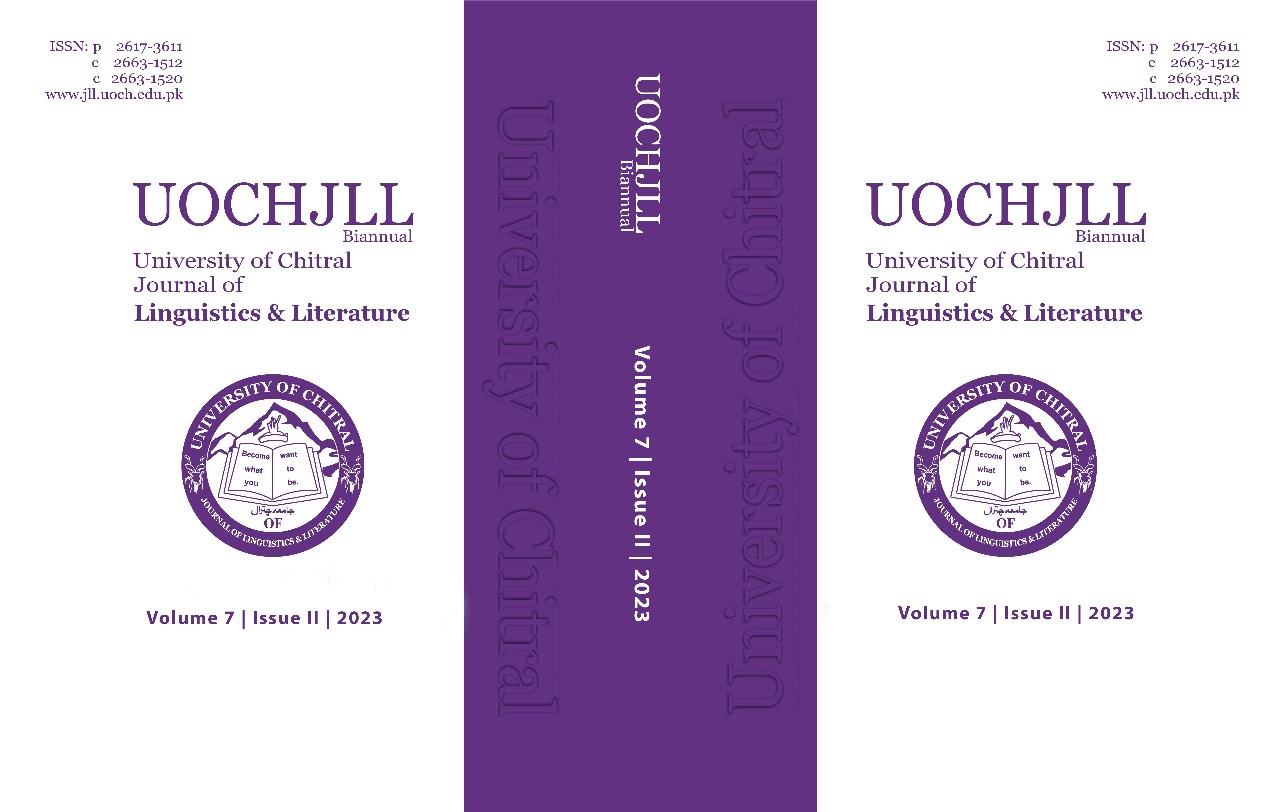Morphosyntactic and Semantic Analysis of Balochi Verbs
DOI:
https://doi.org/10.33195/gbagwx19Keywords:
Affixes, Balochi, Morphemes, Morphology, TensesAbstract
Morphology is broader field of linguistics that studies the structure of words, forms of words and word-formation processes (Zeller, 2001; Zahid, A., 2016). Morphology studies morphemes (the smallest meaningful units of words) and how these morphemes shape words into different grammatical categories and meanings. The current study aims to explore the properties of Balochi verbs in Makrani dialect, and it also tries to find how these morphemes change the form and meaning of the verbs. The current study’s main concern is to analyse and investigate the properties of Balochi morphemes and to find out how these morphemes change the meaning and form of the verbs. For this study, the data have been collected through unstructured interviews from the native participants of Balochi (speaking the Makrani dialect). The data have been analyzed through Radford’s (2009) “theory of agreement”. The study finds that Balochi, being a pro-drop language, works like English and other languages of the world where subject agrees with verb and verb with its subject. It is also found that verbs in Balochi have various properties and these properties are generalized by tense, number, mood, voice, and person.
References
Ali, Z. (2021). Article A Comparative Study of Locative, Source, Goal and Instrumentive Thematic Relations in English and Sindhi. University of Chitral Journal of Linguistics & Literature, 5(II), 237-255.
Ali, Z., Roonjho, Z., & Brohi, F. M. (2021). A Comparison of the Lasi language with English. Progressive Research Journal of Arts & Humanities (PRJAH), 3(2).
Amin, M., & Ali, Z. (2021). Phonological and Morphological Variations between Lasi and Standard Sindhi. Hor J. Hum. & Soc. Sci. Res, 3(2), 181-194.
Allen, R. L. (1966). The verb system of present-day American English (Vol. 24). Mouton.
Axenov, S. (2006). The Balochi Language of Turkmenistan: A corpus-based grammatical description: Doctoral dissertation, Acta Universitatis Upsaliensis.
Baloch, Z. (2015). Balochi Rasth Nabesi. Karachi: Raeesi Chap o Shengjha.
Barjasteh, D. B. (2003). The structure of Present and Past stems in Balochi compared to Old, Middle and New Persian. The Baloch and their Neighbours, 19-31.
Booij, G. (2012). The grammar of words: An introduction to linguistic morphology. Oxford: Oxford University Press.
Sharvit, Y. (2003). Embedded tense and universal grammar. Linguistic inquiry, 34(4), 669-681.
Creswell, J. W. (2014). A concise introduction to mixed methods research: Sage Publications.
Declerck, R. (2015). Tense in English: Its structure and use in discourse: Routledge.
Elfenbein, J. (1989). Baluchistan III: Balochi Language and Literature. Encyclopaedia Iranica III, 633-644.
Embick, D., & Noyer, R. (2007). Distributed morphology and the syntax/morphology interface. The Oxford handbook of linguistic interfaces, 28.9.324.
Fromkin, V., Rodman, R., & Hyams, N. (2007). An introduction to language (eight edition). United States of America.
Fromkin, V., Rodman, R., & Hyams, N. (2018). An introduction to language: Cengage Learning.
Jahani, C. (2003). The Case System in Iranian Balochi in a Contact Linguistic Perspective. The Baloch and Their Neighbours: Ethnic and Linguistic Contact in Balochistan in Historical and Modern Times, 380.
Jahani, C. (2013). The Balochi Language and Languages in Iranian Balochistan. the Journal of Middle East and Africa, 153-167. K12readder.comhttps://www.k12reader.com/term/action-verbs/
Nordquist. R (2017). Glossary of grammatical and rhetorical terms. Retrieved November 27, 2019.
O’Grady, W., & De Guzman, V. P. (1997). Morphology: the analysis of word structure. Contemporary Linguistics. An Introduction. London and New York: Longman.
Radford, A. (2009). An introduction to English sentence structure. Cambridge: Cambridge university press.
Spencer, A. (1991). Morphological theory: An introduction to word structure in generative grammar (Vol. 2). Oxford: Basil Blackwell.
Stewart, T. W., & Vaillette, N. (2001). Language files: Materials for an introduction to language & linguistics. Ohio: Ohio State University Press.
Syal, P., & Jindal, D. V. (2007). An introduction to linguistics: Language, grammar, and semantics: PHI Learning Pvt. Ltd.
Word web dictionary (2006) wordnet database: Woodstock Princeton University.
Yule, G. (2016). The study of language. Cambridge: Cambridge university press.
Veesar, Z. A., Sriniwass, S., & Kadhim, K. A. (2015). A Comparison of Theme Theta Roles in English and Sindhi. Language & Communication, 2(1), 77-89.
Veesar, Z. A., Kadhim, K. A., & Bagudu, R. S. (2015). The Most Prominent Theta Roles in the Sindhi Language: The Hierarchy. International Journal of Foreign Language Teaching and Research, 3(12), 11-24.
Veesar, Z. A., Kadhim, K. A., Shah, S. A., & Khuhro, R. A. (2016). Argument Structure of Sindhi Verbs: An Analysis of Thematic Relations. Language in India, 16(2).
Veesar, Z. A., Kadhim, K. A., & Sriniwass, S. (2015). Establishing the Thematic Structure and Investigating the most Prominent Theta Roles Used in Sindhi Language. International Journal of Applied Linguistics and English Literature, 4(4), 216-230.
Veesar, Z. A., & Mustafa, G. (2021). A Comparative Analysis of Retroflexion in Romani and Lasi: NA. Journal of Education & Humanities Research, University of Balochistan, Quetta-Pakistan, 11(1), 78-95.
Zahid, A. (2016). Morphosemantic and syntactic analysis of verbs in Sindhi/Zahid Ali (Doctoral dissertation, University of Malaya).
Zeller, J. (2001). Lexical particles, semi-lexical postpositions. Semi-lexical categories, 505-49.
Downloads
Published
Issue
Section
License
Copyright (c) 2023 Khursheed Ahmad, Safar Khan, Zahid Ali, Shahbaz Ahmed (Author)

This work is licensed under a Creative Commons Attribution 4.0 International License.
You are free to:
- Share — copy and redistribute the material in any medium or format for any purpose, even commercially.
- Adapt — remix, transform, and build upon the material for any purpose, even commercially.
- The licensor cannot revoke these freedoms as long as you follow the license terms.





